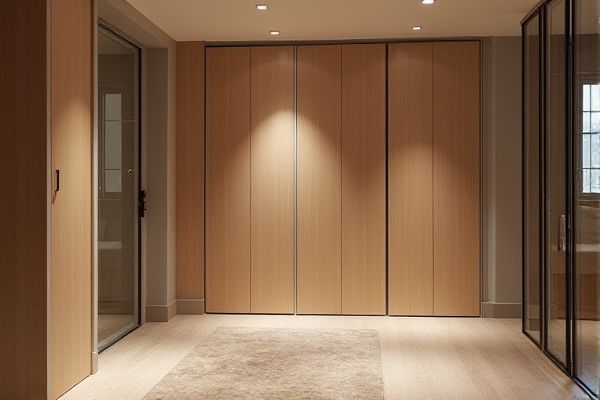
Folding partitions provide flexible space management in basements by allowing you to easily open or close areas, while fixed dividers offer permanent separation and stability. Explore the rest of the article to determine which option best suits your basement layout and needs.
Table of Comparison
| Feature | Folding Partition Basement | Fixed Divider Basement |
|---|---|---|
| Flexibility | Highly flexible; can be folded or unfolded as needed | Permanent structure; no flexibility |
| Installation | Easy to install and remove | Requires professional installation |
| Cost | Generally lower initial cost | Higher upfront cost due to materials and labor |
| Space Efficiency | Optimizes space by folding away | Consumes fixed space |
| Durability | Moderate; depends on materials used | High; built for long-term use |
| Sound Insulation | Limited soundproofing | Better sound insulation |
| Maintenance | Low maintenance | May require repairs over time |
Introduction to Basement Space Division
Folding partitions offer flexible basement space division, allowing you to easily reconfigure rooms based on changing needs without permanent construction. Fixed dividers provide a more durable and stable solution, ideal for defined, long-term separation of areas with added sound insulation. Choosing between these options depends on your desired balance of adaptability and permanence in managing basement layouts.
What Are Folding Partitions?
Folding partitions are versatile movable walls that can easily divide your basement space, offering flexibility that fixed dividers lack. These partitions consist of interconnected panels that fold and slide along a track, allowing you to quickly open or close areas as needed. Ideal for creating temporary rooms or adapting your basement layout, folding partitions enhance functionality without the permanence of traditional fixed dividers.
Understanding Fixed Dividers
Fixed dividers in basements offer permanent structural separation, providing consistent privacy and noise control compared to folding partitions. These dividers are typically constructed from solid materials like drywall or wood, ensuring durability and insulation but lack flexibility for space reconfiguration. Understanding fixed dividers helps you choose a stable and secure option that suits long-term basement layout needs.
Key Differences: Folding Partitions vs Fixed Dividers
Folding partitions offer flexible space management by allowing you to easily open or close areas, enhancing adaptability in your basement layout, while fixed dividers provide permanent separation that maximizes privacy and structural stability. Folding partitions typically use lightweight materials and track systems for effortless operation, contrasting with fixed dividers made from more durable materials like drywall or wood that require professional installation. Choosing between folding partitions and fixed dividers depends on your need for versatility versus long-term separation and noise control in your basement.
Installation Process and Flexibility
Folding partitions offer a quick and flexible installation process, allowing you to easily adjust room layouts as needed without major construction work. Fixed dividers require a more permanent installation involving structural modifications, making them less adaptable to changing space requirements. The choice between these options depends on whether you prioritize immediate adaptability or a stable, long-term division in your basement.
Space Utilization and Functionality
Folding partitions maximize space utilization in basements by allowing flexible room configurations that can be easily adjusted or retracted when not in use, promoting multifunctional areas without permanent barriers. Fixed dividers provide sturdy, permanent separation, enhancing privacy and sound insulation but limiting adaptability and reducing the potential for open, versatile spaces. Selecting between folding partitions and fixed dividers depends on the need for dynamic space management versus consistent, defined room boundaries.
Acoustic Performance Comparison
Folding partitions typically offer moderate acoustic insulation with sound reduction ratings (STC) between 30-45, making them suitable for temporary or flexible space division. Fixed dividers in basements provide superior acoustic performance with STC ratings often exceeding 50, due to their solid construction and permanent installation which effectively block sound transmission. For environments demanding high noise control, fixed dividers remain the optimal choice compared to folding partitions.
Aesthetics and Design Options
Folding partitions in basements offer versatile aesthetics with customizable materials like glass, wood, or fabric, creating dynamic spaces that adapt to changing needs while enhancing natural light flow. Fixed dividers provide a more permanent, structured look with options such as drywall, brick, or custom wood paneling, delivering a cohesive design that complements the basement's architectural style. Both options allow for tailored finishes, but folding partitions emphasize flexibility and modern design innovation, while fixed dividers prioritize stability and traditional aesthetics.
Cost Considerations and Budgeting
Folding partitions typically offer a cost-effective solution compared to fixed dividers, as they require less construction labor and materials, allowing for flexible space management within budget constraints. Fixed dividers involve higher upfront costs due to permanent installation, structural modifications, and often necessitate plumbing or electrical work in basements. Choosing between the two hinges on balancing initial investment with long-term functionality and potential future remodeling expenses.
Choosing the Right Solution for Your Basement
Choosing between a folding partition and a fixed divider for your basement depends on your space flexibility and functional needs. Folding partitions offer versatility, allowing you to easily reconfigure or open up your basement area, optimizing natural light and flow. Fixed dividers provide permanent separation, ideal for creating dedicated rooms or storage, but sacrifice adaptability in future layout changes.
 homyna.com
homyna.com